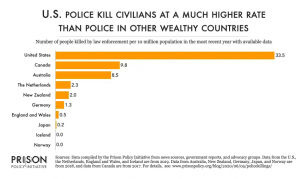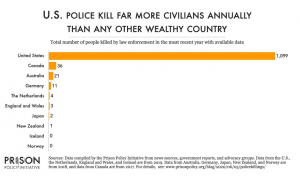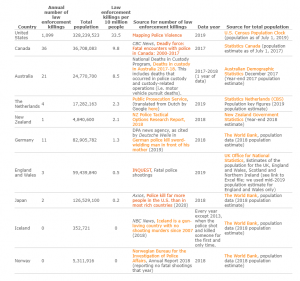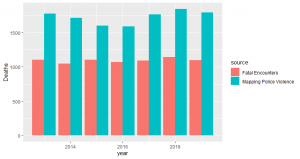Last month the Police Policy Initiative disseminated a blog post putting police killings in the United States in international context:
To its credit, the PPI included a list of sources for its numbers.
One thing that caught my eye was that the number of police killings for the United States comes from the Mapping Police Violence project’s count for 2019, which is substantially smaller than that of the Fatal Encounters project.
Now, both projects rely on media reports to estimate their counts, and in fact Mapping Police Violence says they rely on Fatal Encounters (as well the U.S. Police Shootings Database and KilledbyPolice.net). The difference between FatalEncounters and Mapping Police Violence is that Mapping Police Violence excludes suicides and car crashes. When I wrote the first blog post on this I forgot that FatalEncounters did include such incidents:
We try to document all deaths that happen when police are present or that are caused by police: on-duty, off-duty, criminal, line-of-duty, local, federal, intentional, accidental–all of them.
This is a very broad conceptual definition; Mapping Police Violence’s is a bit narrower:
Police Killing: A case where a person dies as a result of being shot, beaten, restrained, intentionally hit by a police vehicle, pepper sprayed, tasered, or otherwise harmed by police officers, whether on-duty or off-duty.
Again, this reiterates Joel Best’s point about the importance of conceptual breadth for understanding discrepancies in statistics. Arguably, my mistake also illustrates Joel Best’s point about mutant statistics, where people, intentionally or otherwise, garble the meaning of statistics. In my previous post I used the term “police killings” to describe the incidents counted by FatalEncounters, which was a mistake, as FatalEncounter clearly includes incidents where the deceased died by suicide or in a car crash (while being followed by the police).
But the international comparisons are the main point of this post. They are really striking, and other outlets (Axios, The Economist, Vox) have also noted the large discrepancy between the US and other countries in terms of police killings.
Of the countries listed in the PPI graph, I wanted to see the source of the figure for Japan, as that is the largest country of those mentioned in the graph. PPI lists the aforementioned Axios article as the source of the Japan data, and Axios doesn’t give a source. Googling “police killings in Japan” (without the quotes) turns up a Wikipedia article which I suspect is the source for Axios. Like the Axios piece, Wikipedia lists a count of 2 police killings in 2018, and its source is two media reports, one about a police shooting in Sendai and another about a police trainee in Hikone killing his supervising officer for being too mean (which is probably not the kind of incident an American, trying to conjure up the ideal-typical police killing in her mind, would come up with). It seems a bit lame to me that news outlets and think tanks are passing along Wikipedia facts without confirmation. The most recent count when the Economist article appeared in 2014 was a big fat 0; the Economist article is paywalled and the text of the article that I accessed via ProQuest does not mention Japan (my assumption is the Economist article, which was cited by Vox for the zero-police-killings-in-Japan-figure, had a graph showing this number that does not appear in the databases) but I do not know where this came from. If people are really tallying up the number of police killings in Japan by relying on English-language news reports of such incidents I would be very skeptical of that figure; but given Japan’s extremely strict gun control I would not be surprised if it is close to the truth.
If we turn to other major Anglophone countries, Canada’s count comes from journalists who are not very clear on their methodology, but they appear to be applying FatalEncounters’s broad conceptual definition: “every person who died or was killed during a police intervention”. The journalists mention that Canada does not have official statistics on fatal police encounters so I am guessing that, like FatalEncounters, they had to rely on news accounts. The figure for England-Wales comes from a charity dedicated to “state related deaths” (explicitly saying that their mission is only for those two countries in the United Kingdom). Their definition is much narrower: they count up the number of “people who have died as a result of police shootings” so their definition is more inline with the Washington Post’s database that I mentioned in my earlier blog post.
As Joel Best talks about in Damned Lies and Statistics, we really have to be careful about making international comparisons. In this case, PPI took figures for different countries that were constructed by different actors using different definitions. Fortunately for PPI, the inconsistent definitions are not fatal for the point they are making: police killings, while still very rare in the U.S., are much, much rarer in other countries.





